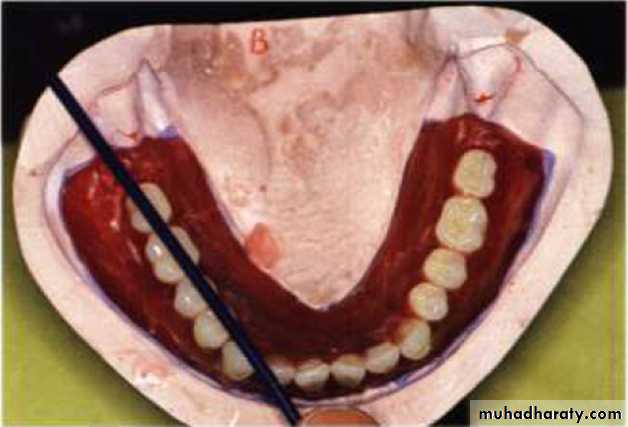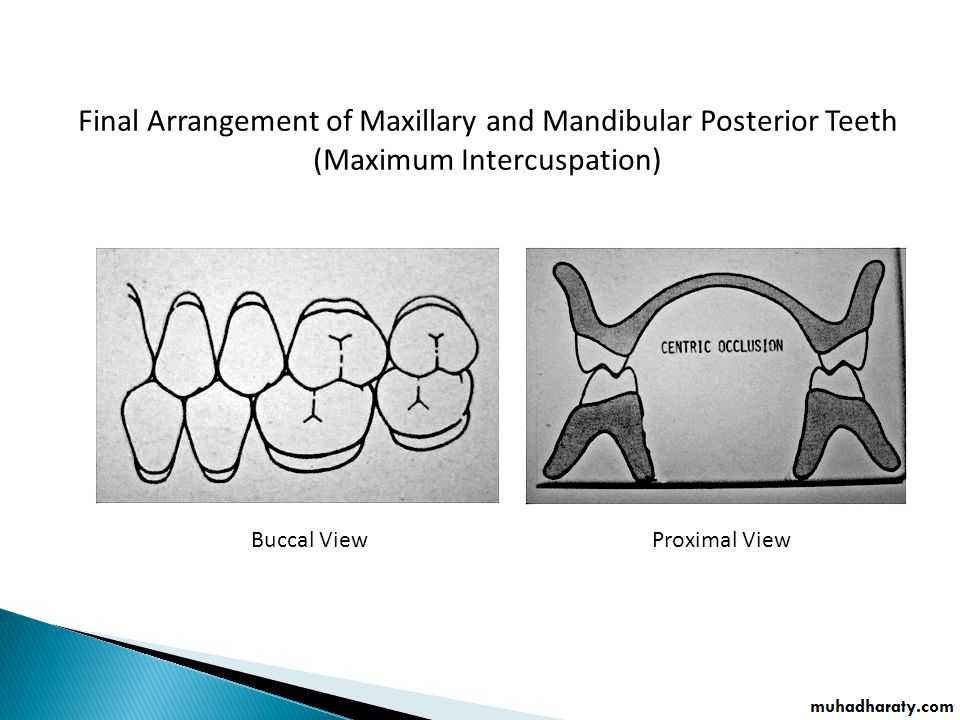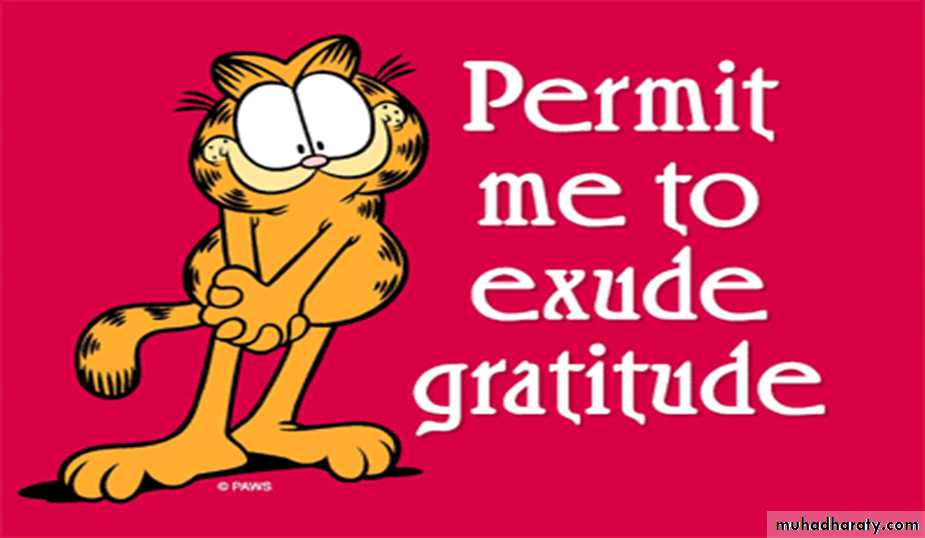• Arrangement of Artificial Teeth in Completely Edentulous patients
Dr. Salah Kh. Al-RawiBDS, MSc, Dental Science, Prosthodontist (Baghdad University)PhD, Maxillo-Facial Prostheses (Universiti Sains Malaysia, USM)
23-5-2016
Arrangement of Teeth
It is the placement of teeth on a denture with definite objective in mind, or it is the setting of teeth on temporary bases.Guide lines of artificial teeth arrangement:
A- Maxillary cast
1- A line is drawn parallel to the frontal plane that passes through the incisive papilla, aids in the positioning of the upper central incisors.
2- The midline follows the mid palatine raphe and bisects the incisive papilla; this line is perpendicular to first line.
3- The canine eminence lines are recorded on the cast where they are present.
B- Mandibular cast
1- A line is drawn parallel to the frontal plane bisecting the residual ridge, aids in positioning of the mandibular central incisors.2- A point designates the distal of the mandibular canine.
3- A line follows the crest of the residual ridge from the canine point to the middle of retromolar pad, aids in the buccolingual position of the mandibular posterior teeth.
4- A line that bisects the vertical height of the retromolar pad aids in establishing the vertical position of the occlusal surfaces of the posterior teeth.
SEQUENCE OF ARIFACIAL TEETH ARRANGEMENT:
1- Maxillary anterior teeth: Following the maxillary occlusion rim.2- Mandibular anterior teeth: Using the occlusion rims and maxillary teeth as guides.
3- Mandibular posterior teeth: Using the anterior teeth, retromolar pads, and residual ridges as guides.
4- Maxillary posterior teeth: Using the mandibular posterior teeth as guides.
ARRANGEMENT OF ANTERIOR TEETH
The anterior teeth should be arranged to provide:1- Proper lip support. Incisal two-thirds of labial surface of teeth supports the lips.
2- Permit satisfactory phonetic.
3- Pleasing esthetic.• Vermilion border of upper lip.
Outward upper lip.
• Corner of mouth (no drooping appearance)
I- Arrangement of the maxillary anterior teeth
1- MAXILLARY CENTRAL INCISORIn frontal view
A- The contact point between the right and left central incisors should be coinciding with the midline of cast.
B- The incisal edge of each one should touch the occlusal plane.
C- The long axis is perpendicular to the occlusal plane.
In sagittal view
The central incisors should have slight (5 degrees) labial inclination.In horizontal view (occlusal plane)
The two central incisors should be placed to give the beginning of curvatures of the arch. Generally the labial surfaces of the two central incisors will be 8-10 mm anterior to the center of the incisive papilla.
2- MAXILLARY LATERAL INCISOR
In frontal viewThe incisal edge of the lateral incisor should be 1 mm above the occlusal plane, and the long axis show little distal inclination.
In horizontal view
The cervical area is depressed more than the central incisor, and the distal edge should be rotated lingually to form the arch curvature.In sagittal view
The upper lateral incisor should have slight labial inclination (10 degrees); the neck is slightly depressed .
3- MAXILLARY CANINE
The maxillary canine represents the corner of the mouth, it is the turning point of the maxillary arch, and also it forms the transition from the anterior teeth to posterior teeth.In frontal view
The tip of the canine should touch the occlusal plane, and the long axis is perpendicular to the plane, or tilted slightly to the distal.
In sagittal view
The long axis of canine is vertical.In horizontal view
The cervical area of canine is prominent and the distal edge should be rotated lingually to form the arch curvature.II- Arrangement of the mandibular anterior teeth
1- MANDIBULAR CENTRAL INCISORIn frontal view
The long axis is vertical and the midline of the mandibular central incisors, coincide with the maxillary midline.
In sagittal view
The mandibular central incisors should have slight labial inclination. The incisal edge should have 1 mm of vertical overlap (overbite), and 1 mm of horizontal overlap (overjet) in respect to maxillary central incisors.In horizontal view
The distal edge rotated lingually to have the arch curvature.2- MANDIBULAR LATERAL INCISOR
In frontal viewThe long axis is slightly distal inclined to the occlusal plane.
In sagittal view
The lateral incisor is fairly upright, and the incisal edge should be 1 mm of horizontal and vertical overlap in respect with the maxillary central incisor.In horizontal view
The distal edge rotated lingually to have the arch curvature.3- MANDIBULAR CANINE
In frontal viewThe long axis should have slight distal inclination, and the tip of the mandibular canine should be placed in the embrasure between maxillary lateral and canine.
In sagittal view
The long axis should have slight lingual inclination.In horizontal view
The cervical area is prominent. The distal edge rotated lingually to have the arch curvature.
• The arrangement of anterior teeth should follow the form of the arch which is ovoid, tapered, or square.
• In complete denture fabrication the mandibular incisors should not touch the maxillary incisors in centric relation to allow free movement of the teeth in eccentric jaw movement without compromising the denture stability.
ARRANGEMENT OF POSTERIOR TEETH
Correct placement of posterior teeth is important for the retention and stability of both dentures.Prior to arrangement of the posterior teeth, we must understand some of the definitions which are related to posterior teeth arrangement
Compensating curve: It is the anteroposterior, and lateral curvature in the alignment of the occluding surfaces and incisal edges of artificial teeth, which is used to develop balanced occlusion.
Christensen’s phenomenon
This is the posterior opening of the dental arches or occlusion rims during forward movement of the mandible.I- Arrangement of the mandibular posterior teeth
The mandibular posterior teeth will be before the maxillary posterior, because there are more anatomical landmarks to locate the guidelines which are:A- The line of the crest of the mandibular residual ridge, which extends between the middle of retromolar pad and tip of mandibular canine, the central grooves of the mandibular posterior teeth should coincide with this line.
B- The line extending between the tip of mandibular canine and upper 2/3 of retromolar pad will determine the height of mandibular posterior teeth.
1- MANDIBULAR FIRST PREMOLAR
In buccal viewThe tooth should be set perpendicular to the occlusal plane. The tip of its buccal cusp should be 1 mm below the line is planed from the tip of canine and the 2/3 of the vertical height of retromolar pad.
In horizontal view
The central groove should be over the crest of residual ridge.3- MANDIBULAR FIRST MOLAR
In buccal viewThe mesiobuccal cusp should be 1 mm below the line, and the distobuccal cusp should be ½ mm below the line.
In horizontal view
The central groove should coincide with the crest of the residual ridge.4- MANDIBULAR SECOND MOLAR
In buccal viewThe mesiobuccal cusp is ½ mm below the line, and the distobuccal cusp should touch the line.
In horizontal view
The central groove should coincide with the crest of the residual ridge.II- Arrangement of the maxillary posterior teeth
1- MAXILLARY FIRST MOLARIn order to get normal molar relation, the mesiobuccal cusp of maxillary first molar should rest in the buccal groove of the mandibular first molar, and the mesiopalatal cusp should seat into the central fossa of mandibular first molar.

















































